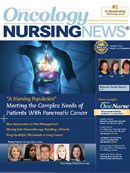Professional Groups Unite to Make Safe Chemo Handling a Priority in Practice
Big changes are ahead for oncology nurses and other healthcare professionals who prepare and administer hazardous drugs, as new regulations for safe handling are being finalized by the US Pharmacopeial Convention (USP).
Martha Polovich, PhD, RN, AOCN
Big changes are ahead for oncology nurses and other healthcare professionals who prepare and administer hazardous drugs, as new regulations for safe handling are being finalized by the US Pharmacopeial Convention (USP).
These imminent regulatory changes make the time especially ripe for stakeholders to enlist and support their members in efforts to improve practice.
Six oncology professional organizations gathered in Washington, DC, recently to outline key issues for healthcare practitioners involved in the preparation and administration of hazardous drugs. The meeting was hosted by the Oncology Nursing Society (ONS) and attended by 14 nurses and other professionals representing the American Society of Clinical Oncology (ASCO), the American Society of Health-System Pharmacists, the Association of Community Cancer Centers, the Association of Pediatric Hematology/Oncology Nurses, and the Hematology/Oncology Pharmacy Association (HOPA).
More than 50 studies have demonstrated the presence of hazardous drugs in the urine of healthcare workers, indicating actual exposure. Occupational exposure to hazardous drugs has been associated with acute symptoms such as nasal sores and hair loss, adverse reproductive outcomes such as infertility and miscarriages, genetic changes such as DNA damage, and an increased occurrence of cancer, according to a review of the research literature by the Centers for Disease Control and Prevention.
“Nurses should not have to risk their health and safety when caring for patients who are receiving chemotherapy,” said Martha Polovich, PhD, RN, AOCN, who currently leads the ONS Chemotherapy and Biotherapy Special Interest Group. “Yet, healthcare is the only industry in the United States where protection against exposure to carcinogens is optional.”
USP 800’s Wide Reach
A joint position statement on safe handling was finalized at the stakeholder meeting and formally endorsed by ONS, ASCO, ad HOPA. Polovich said that ONS had been working on a position statement for well over a year, and ASCO also had its own working group on hazardous drug exposure. Release of the proposed USP Chapter 800 for public comment last fall spurred much interest, she added, and it made sense to build on that momentum and bring other oncology groups together to focus on safe handling in clinical practice.
The proposed USP Chapter 800, Hazardous Drugs—Handling in Healthcare Settings, generated a lot of public comment, and USP decided to allow additional time (through May 31, 2015) for public review and comment on a republished version reflecting that input. Publication of the final USP Chapter 800 is anticipated early in 2016. Previously, hazardous drug preparation was covered under USP Chapter 797 involving sterile drug preparation and patient safety guidelines, so a new chapter devoted to safe handling in healthcare settings is significant, said Polovich.
“Because USP 800 is an enforceable standard, that’s why there is more interest now, because people will be held accountable. It has implications for organizations to make sure they are doing everything right.”
Mandating the use of closed system transfer devices (CSTDs) for drug administration is part of USP 800, and this has implications for practice, Polovich explained, including costs for organizations who must provide the devices and training for nurses who haven’t been using these devices in the past.
“The main concern is that USP has an implementation timeline that would allow organizations to phase this in over time,” said Polovich. “And I think that they will.”
Polovich is a clinical associate professor at the Byrdine F. Lewis School of Nursing and Health Professions at Georgia State University and a consultant on the training portion of a multisite study of oncology nurse exposure to hazardous drugs funded through a $2.2 million grant from the National Institute of Occupational Safety and Health. Other activities under the grant include spill management and, importantly, measuring the extent to which nurses are exposed to hazardous chemotherapy in practice and assessing the impact of targeted interventions to prevent such exposure.
This recent focus on hazardous drug exposure has led to greater awareness, said Polovich, noting that she has seen more awareness among staff and administrators, especially in the context of the regulatory issues associated with USP 800.
“I’ve always thought that nurses are responsible for their own practice, but basically we’re employees in organizations, and so the focus needs to be on the organizations, because if they don’t change, the nurses can’t change. You can’t use personal protective equipment (PPE), for example, if your employer doesn’t provide it.
“As organizations get on board—and they’ll have to because of USP 800—we’re going to see more movement in the next couple of years.”
Tools for Practitioners
The stakeholder groups have identified areas of common ground for further collaboration in the coming months. The priority, Polovich said, will be on getting the information out to their respective members. Among the consensus statements agreed at the stakeholder meeting are to provide resources, including templates, to promote compliance with implementing safe handling; develop resources for how to use PPE and CSTDs; and provide free access to a medical surveillance questionnaire template.
“That’s where our focus will be over the next several months, providing tools so that staff can make the practice changes that they need to," Polovich concluded.





